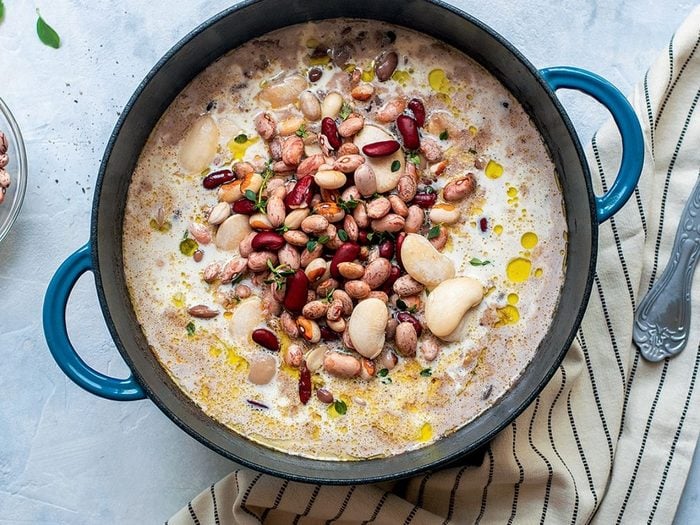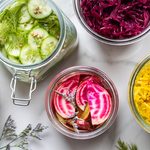Why You May Want to Eat Brothy Beans

They make a super nutritious (and budget-friendly) dinner.
Beans are a staple in most cuisines around the world, and for good reason. They’re nutritious, affordable, convenient to make and comforting. Both canned and dried beans are a good source of plant-based protein, fibre and iron to keep you feeling energized and full over longer periods of time. Most beans are also an excellent source of potassium, which helps to keep blood pressure levels in check. Perhaps the best part about beans, though, is how easily they can transform from a plain pantry staple to a truly wonderful and satisfying meal.
The benefits of cooking with dried beans
It’s true that cooking dried beans may not sound that appealing—they can’t compete with canned when it comes to convenience. But for recipes where beans take centre stage, dried are well worth the extra time and effort. By adding your own seasonings from the start, you can impart big flavour and control the salt levels. (Canned beans contain added salt, which you can partially remove by draining and rinsing them, but it’s worth keeping in mind if you are looking to reduce your sodium intake.)
Dried beans lend themselves well to batch cooking, since it’s easy to cook up a large quantity at once, and you can freeze them after cooking to add to future meals. They also yield a cheaper cost per serving than canned. Another benefit to dried is texture: Dried beans maintain their shape better during cooking, while remaining soft and creamy on the inside, whereas canned beans tend to turn mushy and break down.
Choose your bean adventure
The same cooking method can be used for almost all dried beans, which can then be eaten as is, or added to soups and salads or blended into dips and purees. For saucy dishes where beans are the main attraction, I love a creamy, starchy white bean such as a cannellini, great northern or gigantes. For chilis, I’m partial to smaller and sturdier black beans, and my go-to for a low-effort curry is always quick-cooking, nutritionally dense red lentils.
(Related: How to Incorporate More Beans and Plant-Based Proteins into Your Diet )
Don’t forget to prep
Most dried beans benefit from a pre-cooking soak for a few reasons. Soaking the beans in water plumps them up, helps them soften and leads to a shorter cook time. Soaking also helps to wash away some of the compounds in beans called lectins that can create uncomfortable gastrointestinal effects like gas and bloating. For smaller, thin-skinned varieties like lentils, black eyed peas and split mung beans, you can skip the soak and opt for a rinse instead—it will still help reduce the lectins.
How to make brothy beans
At the minimum, you’ll want to add salt to season the beans from the inside out as they cook (ballpark about 1 tablespoon per pound of beans used). Salt also helps beans retain their shape during cooking, for a tender interior with a bit of resistance when you bite into it. You can throw in woody herbs like rosemary, thyme, bay leaf and oregano; leafy herbs like parsley, cilantro and dill; a halved lemon (try searing it cut-side down in a hot pan before adding it to the pot for extra flavour); onions or shallots; fresh or dried chilies; and even a hunk of smoked bacon or ham hock.
Once you’ve selected your cast of flavours, bring the pot of beans to a simmer, and cook over low heat until they’re cooked through and tender. Don’t rush this process: Amping up to a boil will make the beans tough and cause their skins to split. Once cooking is complete, you can add in acidic elements like a splash of vinegar or lemon juice to brighten things up (adding them too early in the cooking process can prevent beans from softening). To make your broth extra creamy, stir a spoonful of aioli or an egg yolk into the hot liquid right after plating into bowls.
Once cooked, store beans in their cooking liquid in the refrigerator to prevent them from shriveling, or freeze them for meals down the line. That cooking liquid is a highly flavourful, aromatic broth, so save it to use as the base of soups, in braises or as a replacement for pasta water to thicken pasta sauces.
After my first bowl of creamy, brothy beans, I was hooked. The perfectly seasoned leftovers in the freezer I used for minestrone the following week clinched it: Consider me a dried-bean convert.
Next: How to Make Pizza Beans, an Easy Protein-Packed Side Dish




